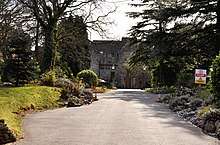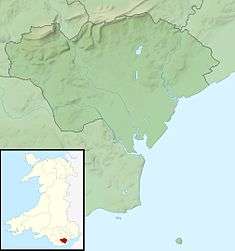Craig-y-parc House
Craig-y-parc House is a country house in Pentyrch, Cardiff, Wales. Dating from 1914-1918, it was built for Thomas Evans, a colliery owner, by Charles Edward Mallows. The house reputedly cost £100,000. Craig-y-parc is a Grade II* listed building. The garden and park surrounding the house has its own Grade II* listing and is a designated conservation area. The house now operates as a residential school for children and young adults with disabilities.
| Craig-y-parc House | |
|---|---|
 "Under the spell of Lutyens, a beautifully resolved composition", John Newman | |
| Type | House |
| Location | Cardiff, Glamorgan |
| Coordinates | 51.5192°N 3.3042°W |
| Built | 1914-1918 |
| Architect | Charles Edward Mallows |
| Architectural style(s) | Arts and Crafts |
| Governing body | Salutem Healthcare |
Listed Building – Grade II* | |
| Official name: Craig-y-parc House | |
| Designated | 31 January 2000 |
| Reference no. | 22816 |
Listed Building – Grade II* | |
| Official name: Loggia at Craig-y-parc and attached terrace walls and steps | |
| Designated | 31 January 2000 |
| Reference no. | 22817 |
Listed Building – Grade II* | |
| Official name: Garden terrace and steps at Craig-y-parc | |
| Designated | 31 January 2000 |
| Reference no. | 22818 |
Listed Building – Grade II | |
| Official name: Walls and gatepiers to courtyard entrance at Craig-y-parc | |
| Designated | 31 January 2000 |
| Reference no. | 22819 |
Listed Building – Grade II | |
| Official name: Lodge at Craig-y-parc | |
| Designated | 31 January 2000 |
| Reference no. | 22820 |
 Location of Craig-y-parc House in Cardiff | |
History
Thomas Evans began his career as a railwayman. Known as "Small Coal Evans", he reputedly made his fortune by collecting coal that had fallen from coal trucks operating on the railways in the South Wales Coalfield.[1] By 1940, he held a CBE, was the Chairman of the Cardiff Coal and Shipping Exchange, Vice-Chairman of the Ocean Coal Company and a Justice of the peace for Glamorganshire.[2] In 1914, Evans commissioned Charles Edward Mallows to build a house some seven miles north of Cardiff in woods close to the village of Pentyrch. Mallows, who died the year after work had begun,[3] was an architect in the Arts and Crafts style, much influenced by Edwin Lutyens.[4] His major work was Tirley Garth in Cheshire, another Lutyenseque house for another rich industrialist.[5] Mallows also had full responsibility for the design of the gardens surrounding the house, which he laid out to an Arts and Crafts-influenced design.[6] The whole reputedly cost Evans a sum in excess of £100,000.[1]
Following Evans' death, Craig-y-parc came into the possession of the Coal Board before being sold in 1954 to the Spastics Society which opened a residential school at the site in 1955.[7] The school continues to provide residential care for children and young adults with disabilities, operated by Salutem Healthcare.[8]
Architecture and description
Craig-y-parc is a large mansion with the entrance front to the north, and the garden front, onto which all the main receptions rooms face, to the south.[1] The architectural historian John Newman, in his Glamorgan volume of the Buildings of Wales, notes the strong influence of Lutyens.[4] This is seen particularly in the lodge, and in the north frontage, which Newman compares to Little Thakeham. He admires Mallow's originality on the garden front, where a row of columns forms an arcade.[4] The house is constructed of locally-quarried stone, with granite dressings. The house is listed at Grade II*.[1] The gardens are also listed at II*, on the Register of Historic Parks and Gardens of Special Historic Interest in England. The listing record notes their "strongly axial design" and considers them "a very good example of [an] architectural Edwardian garden".[6] The loggia,[9] and the garden terrace have their own Grade II* listings,[10], while the lodge, [11] and the walls and gate piers at the courtyard entrance are listed Grade II.[12]
References
- Cadw. "Craig-y-parc House (Grade II*) (22816)". National Historic Assets of Wales. Retrieved 9 August 2020.
- "Durham Mining Museum - Thomas Evans, C.B.E." www.dmm.org.uk. Durham Mining Museum. Retrieved 9 August 2020.
- "Charles Edward Mallows - biography". www.scottisharchitects.org.uk. Dictionary of Scottish Architects. Retrieved 9 August 2020.
- Newman 1995, p. 513.
- Historic England. "Tilney Garth (Grade II*) (1330306)". National Heritage List for England. Retrieved 9 August 2020.
- "Craig y parc". Parks and Gardens UK. Retrieved 9 August 2020.
- "Craig-y-parc House, Pentyrch, Cardiff, Cardiff". britishlistedbuildings.co.uk. British Listed Buildings online. Retrieved 9 August 2020.
- "Craig Y Parc School". Salutem Healthcare. Retrieved 9 August 2020.
- Cadw. "Loggia at Craig-y-parc and attached terrace walls and steps (Grade II*) (22817)". National Historic Assets of Wales. Retrieved 9 August 2020.
- Cadw. "Garden terrace and steps at Craig-y-parc (Grade II*) (22818)". National Historic Assets of Wales. Retrieved 9 August 2020.
- Cadw. "Lodge at Craig-y-parc (Grade II) (22820)". National Historic Assets of Wales. Retrieved 9 August 2020.
- Cadw. "Walls and gatepiers to courtyard entrance at Craig-y-parc (Grade II) (22819)". National Historic Assets of Wales. Retrieved 9 August 2020.
Sources
- Newman, John (1995). Glamorgan. The Buildings of Wales. London, UK: Penguin. ISBN 0140710566.